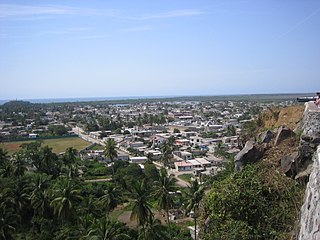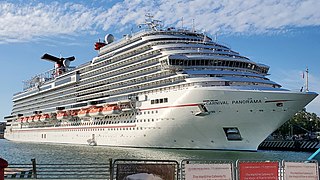
Puerto Vallarta is a Mexican beach resort city situated on the Pacific Ocean's Bahía de Banderas in the Mexican state of Jalisco. Puerto Vallarta is the second largest urban agglomeration in the state after the Guadalajara Metropolitan Area. The City of Puerto Vallarta is the government seat of the Municipality of Puerto Vallarta which comprises the city as well as population centers outside of the city extending from Boca de Tomatlán to the Nayarit border . The city is located at 20°40′N105°16′W. The municipality has an area of 1,300.7 square kilometres (502.19 sq mi). To the north, it borders the southwest part of the state of Nayarit. To the east, it borders the municipality of Mascota and San Sebastián del Oeste, and to the south, it borders the municipalities of Talpa de Allende and Cabo Corrientes.

Tourism in Mexico is a very important industry. Since the 1960s, it has been heavily promoted by the Mexican government, as "an industry without smokestacks." Mexico has traditionally been among the most visited countries in the world according to the World Tourism Organization, and it is the second-most visited country in the Americas, after the United States. In 2017, Mexico was ranked as the sixth-most visited country in the world for tourism activities. Mexico has a significant number of UNESCO World Heritage sites with the list including ancient ruins, colonial cities, and natural reserves, as well as a number of works of modern public and private architecture. Mexico has attracted foreign visitors beginning in the early nineteenth century, cultural festivals, colonial cities, nature reserves and the beach resorts. The nation's temperate climate and unique culture – a fusion of the European and the Mesoamerican are attractive to tourists. The peak tourism seasons in the country are during December and the mid-Summer, with brief surges during the week before Easter and Spring break, when many of the beach resort sites become popular destinations for college students from the United States.

Hurricane Kenna was the fourth-most intense tropical cyclone on record in the Eastern Pacific basin, and at the time the third-most intense Pacific hurricane to strike the west coast of Mexico. Kenna was the sixteenth tropical depression, thirteenth tropical storm, seventh hurricane, sixth major hurricane, and third Category 5 hurricane of the 2002 Pacific hurricane season. After forming on October 22 to the south of Mexico from a tropical wave, forecasters consistently predicted the storm to strengthen much less than it actually did. Moving into an area of favorable upper-level conditions and warm sea surface temperatures, Kenna quickly strengthened to reach peak winds of 165 mph (270 km/h) as a Category 5 hurricane, on October 25, while located about 255 mi (410 km) southwest of Puerto Vallarta, Jalisco. Weakening as it turned to the northeast, the hurricane made landfall near San Blas, Nayarit as a Category 4 hurricane, with sustained winds of 140 mph (220 km/h), before dissipating on October 26 over the Sierra Madre Occidental mountains.

San Blas is both a municipality and municipal seat located on the Pacific coast of Mexico in Nayarit.
Aticama is a small farming and fishing community located in the state of Nayarit, Mexico. It is situated approximately 90 miles north of Puerto Vallarta and near the town of San Blas on a stretch of coastline known as the Riviera Nayarita. Aticama's beach is known as Playa Matanchen and is one of the widest and sandiest beaches in Mexico. Aticama is an important producer of rock oysters, shrimp, rock lobster, and fish such as mahi mahi and robalo. It is also a major producer of mangos and bananas. In colonial times, it was a haven for pirate ships and buccaneer on the Pacific coast.
MVS Radio are a group of four international Spanish radio networks owned by the mass media conglomerate MVS Comunicaciones. The group of radio networks consists of Exa FM, La Mejor, FM Globo and MVS Noticias and are broadcast in a various Latin American countries including Argentina, Costa Rica, Ecuador, El Salvador, Honduras, Mexico, Panama and the United States.
Federal Highway 200, also known as Carretera Pacífico, is a Federal Highway of Mexico. The Carretera Pacífico is the main leg of the Pacific Coastal Highway within Mexico and travels along the Pacific Coast from Mexican Federal Highway 15 in Tepic, Nayarit in the north to the Guatemala-Mexico border at Talismán, Chiapas in the south. Upon entering Guatemala, the highway continues as Central American Highway 1.
The Pacific Naval Force is the Mexican Navy's presence in the Pacific Ocean. Its headquarters is in Manzanillo, Colima. The Pacific Naval Force was created in the same date as its Gulf of Mexico and Caribbean Sea counterpart on February 11, 1972. The Surface ships are the main components of The Naval Force and is the means to secure and to operate sea control in strategic areas. Main objectives of the Naval force is to Defend the sovereignty and integrity of Mexico from sea, protect vital naval installations, protect human life and maintain marine traffic and maintain the rule of law in national waters.

Grupo Vidanta is a Mexican conglomerate involved in design, construction, financing, and operation and maintenance of hotels, resorts, cruises, and associated infrastructure. It also owns and operates the Mar de Cortés International Airport. Grupo Vidanta was founded by Daniel Chávez Morán in 1974 and is headquartered in Nuevo Vallarta, Mexico. The group has 25,000 employees and an estimated annual revenue of US$750 million.

The Pacific Coast of Mexico or West Coast of Mexico stretches along the coasts of western Mexico at the Pacific Ocean and its Gulf of California.

Vida Vacations is a vacation membership company, which allows its customers to purchase a Right to Use and, more recently, a real estate interest in 15 resorts in Mexico. It was founded in 2010 by Grupo Vidanta, and was originally named "Vida Vacation Club".Before that, in the 1990s it was called Vidafel and sold timeshares. The total number of rooms is approximately 7,000.
The following television stations broadcast on digital channel 36 in Mexico:
The following television stations broadcast on digital channel 23 in Mexico:
The following television stations broadcast on digital channel 21 in Mexico:
Federal Highway 200D is the toll highways paralleling Fed. 200, and has two separate improved segments of designated roadway. Fed200D in Colima funnels traffic from Manzanillo toward Fed. 110 to Colima City; the segment in Guerrero serves as a bypass of Tecpán de Galeana.

Carnival Panorama is the current flagship of Carnival Cruise Line. As such, the 133,868 GT, 323 m long Vista-class cruise ship is the largest in the fleet. She is also Carnival's 27th operating vessel and the final Vista-class ship in the fleet, which includes Carnival Vista and Carnival Horizon. The ship was originally designed and ordered for P&O Cruises Australia but she was transferred to Carnival Cruise Lines during construction.











